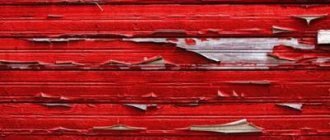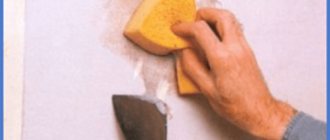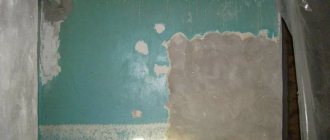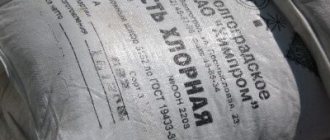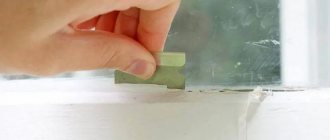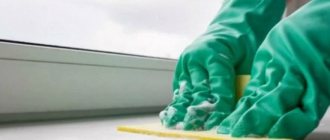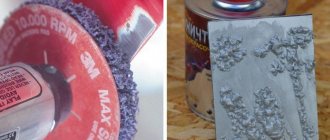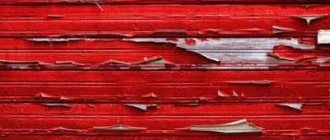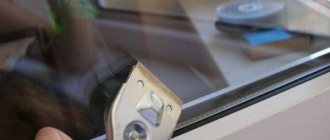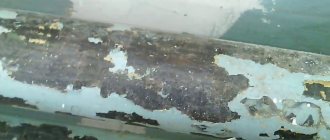Removing paint from a wooden surface without damaging it is not an easy task, but you can cope with it if you know some of the features of the work.
There are several methods to achieve your goal. Paint is removed mechanically, thermally and chemically, each of which has its own advantages and disadvantages.
You can learn how to remove old paint from wood at home from this article.
How to properly prepare for upcoming work?
It is wrong to immediately start removing paint from wood. First you need to prepare. Depending on the cleaning method chosen, the following tools and accessories may be required:
personal protective equipment: goggles, gloves, mask, respirator;- rags;
- spatula, sandpaper;
- construction hair dryer;
- drill or grinder;
- grinding machine and attachments;
- solvent.
When all the tools are collected, you need to think about the following points:
- Place of work . If a chemical cleaning method is intended, then it is best to do it outside or in a room with good ventilation.
- Protection of surrounding objects and surfaces . They need to be covered with unnecessary cloth or plastic wrap.
- Ease of access . If there is such a need, then the object being cleaned must be moved in advance.
- Thickness of paint coating . If the layer is thin, then new paint can be applied directly to it, without preliminary cleaning. It is better to remove thick coating. The preferred method is mechanical cleaning.
- Recency of coating application . The old layer of paint can be easily removed from wood, so it should not be left behind. Otherwise, the new coating will lie unevenly and will peel off.
If the surface of the product is ribbed or has a complex topography, then preference should be given to the chemical method.
Types of washes
The specialized market is dominated by universal compositions - they are usually chosen by beginners who doubt the essence of the old coating that they have to get rid of. Specialized removers work more “targetedly”, allowing you to dissolve specific types of paintwork without residue.
Universal substances
They are relevant if the type of original coating is not known; they are also in demand due to their reasonable cost - this is a convenient solution for a limited budget. They cannot boast of high efficiency, since removing the old layer will require more effort and time. Solvents, which are invariably present in the composition, quickly evaporate, as a result of which the consumption of the chemical cocktail increases.
Universal liquid remover for wood
Specialized removers
The principle of operation of all variations is the same: substances actively interact with the coating, so the latter is destroyed. The compositions of paints can have fundamental differences, so it is advisable to use narrow-profile solvents that have a targeted effect. You can find mixtures that eliminate the following types of paints:
- alkyd,
- polyurethane,
- nitrocellulose;
- oil;
- epoxy;
- pentaphthalic.
All of them are effective and have a fast effect.
Which option should you prefer?
When giving preference to one or another method of cleaning, you need to start from the specific task that a person faces, namely:
- If the surface needs high-quality treatment, then two methods are combined: first, the object is treated with a professional solvent, and then the areas are cleaned manually.
- If you need to save money, clean it using sandpaper or using foil and an iron.
- When safety comes to the fore, dry cleaning is chosen.
If a person has enough time to carry out the work, then several methods can be used simultaneously: apply a chemical remover, and then clean off the remaining paint manually.
Safety precautions
Removing paint from the floor is not too difficult, but when carrying out this work, certain rules must be followed:
Use heating devices with extreme caution, avoiding burning and inhaling vapors generated during heating of varnish and paint, while wearing a respirator. In addition to the latter, when using any of the methods, it is necessary to use other personal protective equipment that will prevent damage from vapors and dust not only to the respiratory tract, but also to the skin of the hands, wearing rubber gloves and goggles for this, which will provide protection to the eyes. Be sure to follow the instructions for using chemical compounds and tools. Before treating the floor covering with the chosen method, you must first test it on a small and less noticeable area, since in some situations any of the methods may be ineffective or ineffective. If you follow all these recommendations, you will be able to avoid many negative consequences
If you follow all these recommendations, you will be able to avoid many negative consequences.
Features for different types of dyes
Depending on the type of dye, the methods for removing it will vary:
oily compounds can be easily cleaned off with a spatula or grinder;- water-based paints are susceptible to solvents;
- acrylic paint can be cleaned off mechanically or chemically;
- powder paints are washed off with a powerful stream of water, for example, from a high-pressure washer;
- Hair dye that gets on a wooden surface can be washed off with an alcohol solution.
It is most effective to remove several layers of different paint using the thermal method.
The most common mistakes
The most common mistakes people make when trying to remove paint from wood surfaces are:
- Applying chemicals to the entire area at once. If the composition is used for the first time, then first you need to treat a small area.
- Cleaning wood with too hard brushes or rough abrasive attachments. They can lead to rock destruction.
- Long-term exposure of removers and solvents on a wooden surface. Even the most expensive and effective washes can lead to damage to the product. Therefore, leaving them for longer than 1-2 hours is not recommended.
- Overheating of the surface when trying to remove paint using a thermal method. This situation is a fire hazard.
- Using plastic containers when working with washes. Aggressive compounds can lead to their damage.
Regardless of the cleaning method you choose, you should carefully read the instructions for its use.
Methods for removing old coating from wood
The durability and quality of repairs directly depends on the preparation of the base. Of course, you can apply a new coating over the old one, but the appearance of such a finish will be far from ideal, and the durability of the coating remains a big question. Therefore, so that the time spent on repairs and money on materials are not wasted, it is necessary to remove the old paintwork.
There are several ways to perform this procedure:
- Mechanical;
- Thermal;
- Chemical.
To make it clearer what the advantages of washing are, let’s briefly consider the features of these methods.
Removing paint with sandpaper
Mechanical
The oldest and most famous is the mechanical method. As a rule, there is no alternative to it in small areas. It is done with your own hands using a sharp tool or sandpaper. With a lot of effort, after some time you can get an acceptable result. .
If you need to clear a large area of old finishing, you will have to use a power tool, for example, a grinder or a drill with a special attachment. This work takes a lot of time and effort, and it is not always possible to achieve the desired result.
Another serious disadvantage of this type of paint removal is the high likelihood of damage to the wood surface.
Removing paint using a hair dryer
Thermal
A much more technologically advanced method is the thermal method. Previously, irons were used for these purposes, which heated paint through foil, and blowtorches. In our time, construction hair dryers have appeared, which have greatly simplified this procedure. .
The essence of this method is that the paint is heated to a high temperature, after which it softens and swells. After this, it can be easily removed with a scraper or brush.
This method is more effective and not as dusty as the mechanical one, however, it is not always possible to use it. In addition, you will need a professional-grade hair dryer, which not everyone has.
In the photo - applying the wash
Chemical
Not so long ago, this method was ineffective and quite dangerous. As a rule, it consisted of using solvents corresponding to the type of painted surface. In addition, there are folk recipes that contain dangerous acids or alkalis .
However, all these products, in addition to being toxic, are ineffective in removing multi-layer coatings. In addition, solvents quickly begin to evaporate, reducing the effectiveness of this method to zero and saturating everything around with toxic fumes.
The situation has changed dramatically with the advent of special removers, which loosen old paint and make it extremely easy to remove mechanically. The main advantage of the remover is the ability to remove paint without damaging the surface of the wood.
Important Tips
To ensure that the process of removing paint from wood is effective and safe, the following recommendations must be followed:
Do not press on the surface of the product with great force. This is true for the mechanical cleaning method.- Always use personal protective equipment.
- Protect floors and surroundings with plastic film.
- Do not heat the wall in the area of wiring and electrical appliances.
- After applying the remover, the surface must be washed with clean water.
- If aggressive substances come into contact with the skin or mucous membranes, rinse them immediately with plenty of water.
By following these recommendations, you can efficiently remove paint from any surface.
Key features of paint and varnish removers from wood
Chemical removers for paint and varnish on wood are a category of specialized solutions that quickly dissolve or loosen old layers of paintwork. As a result, the adhesive properties of the latter deteriorate. When compared with mechanical methods of cleaning surfaces, a more even, smooth wood is formed here, which is free of abrasive damage and signs of abrasions. Chemical treatment does not affect the original properties of the base.
The wash can be used locally if you choose a sufficiently viscous composition: the gel consistency will not allow the reagents to spread over the surface. Therefore, the substances are convenient to use not only when restoring large wooden structures, but also when restoring interior items and furniture.
Remover-gel for removing old paint and varnish coatings
When choosing the best option, several factors must be taken into account:
- compliance with the type of layer to be removed and the specifics of the working composition - this way you can avoid an undesirable destructive effect;
- if there is a large area to be processed, it is more advisable to use a solution that operates relatively quickly so that there is no downtime;
- the instructions always indicate at what humidity and ambient temperature this product can be used; real conditions must correspond to the given parameters;
- the composition should not contain toxic components.
The simpler the proposed application technology, the better: it is important that convenient tools are available so that the density of the substance corresponds to the tasks.
Characteristics of a successful remover for oil or any other paint:
- versatility of use;
- gentle wood processing;
- fast action;
- fire safety;
- absence of unpleasant odors;
- economical consumption;
- deep penetration;
- maintaining original properties after defrosting.
High-quality preparations are effective for removing old paint even at sub-zero temperatures; they must be safe for humans.
